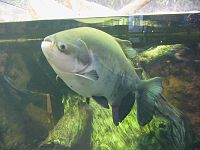
Photo from wikipedia
Tambaqui, Colossoma macropomum, is the main native fish species produced in Brazil, and is an important species for genetic improvement in aquaculture. In addition, breeding studies on this species can… Click to show full abstract
Tambaqui, Colossoma macropomum, is the main native fish species produced in Brazil, and is an important species for genetic improvement in aquaculture. In addition, breeding studies on this species can be optimized with the use of molecular markers associated with productive phenotypes. The objective of the present study was to test the performance of growth traits and resistance to the bacteria, Aeromonas hydrophila, in association with microsatellite markers in C. macropomum. In this study, three full-sib families were subjected to bacterial challenge and morphometric growth assessments. Tambaqui families subjected to the bacterial challenge differed significantly in death time and mortality rate. There was, however, no association between resistance to bacteria and microsatellite markers. In relation to growth traits, we observed a marker/phenotype association in two microsatellites. The marker in the 6b isoform x5 gene (TNCRC6b) was associated with length, whereas an anonymous marker was associated with height. The present study highlighted the evaluation of molecular markers associated with growth traits, and can serve as the basis for future marker-assisted selection (MAS) of tambaqui.
Journal Title: Frontiers in Genetics
Year Published: 2018
Link to full text (if available)
Share on Social Media: Sign Up to like & get
recommendations!